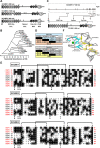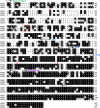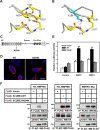The biology of SCUBE
- PMID: 37237303
- PMCID: PMC10214685
- DOI: 10.1186/s12929-023-00925-3
The biology of SCUBE
Abstract
The SCUBE [Signal peptide-Complement C1r/C1s, Uegf, Bmp1 (CUB)-Epithelial growth factor domain-containing protein] family consists of three proteins in vertebrates, SCUBE1, 2 and 3, which are highly conserved in zebrafish, mice and humans. Each SCUBE gene encodes a polypeptide of approximately 1000 amino acids that is organized into five modular domains: (1) an N-terminal signal peptide sequence, (2) nine tandem epidermal growth factor (EGF)-like repeats, (3) a large spacer region, (4) three cysteine-rich (CR) motifs, and (5) a CUB domain at the C-terminus. Murine Scube genes are expressed individually or in combination during the development of various tissues, including those in the central nervous system and the axial skeleton. The cDNAs of human SCUBE orthologs were originally cloned from vascular endothelial cells, but SCUBE expression has also been found in platelets, mammary ductal epithelium and osteoblasts. Both soluble and membrane-associated SCUBEs have been shown to play important roles in physiology and pathology. For instance, upregulation of SCUBEs has been reported in acute myeloid leukemia, breast cancer and lung cancer. In addition, soluble SCUBE1 is released from activated platelets and can be used as a clinical biomarker for acute coronary syndrome and ischemic stroke. Soluble SCUBE2 enhances distal signaling by facilitating the secretion of dual-lipidated hedgehog from nearby ligand-producing cells in a paracrine manner. Interestingly, the spacer regions and CR motifs can increase or enable SCUBE binding to cell surfaces via electrostatic or glycan-lectin interactions. As such, membrane-associated SCUBEs can function as coreceptors that enhance the signaling activity of various serine/threonine kinase or tyrosine kinase receptors. For example, membrane-associated SCUBE3 functions as a coreceptor that promotes signaling in bone morphogenesis. In humans, SCUBE3 mutations are linked to abnormalities in growth and differentiation of both bones and teeth. In addition to studies on human SCUBE function, experimental results from genetically modified mouse models have yielded important insights in the field of systems biology. In this review, we highlight novel molecular discoveries and critical directions for future research on SCUBE proteins in the context of cancer, skeletal disease and cardiovascular disease.
Keywords: Biomarker; Coreceptor; Endothelial cells; SCUBE; Signal transduction.
© 2023. The Author(s).
Conflict of interest statement
The authors declare no competing interests.
Figures











Similar articles
-
Zebrafish scube1 (signal peptide-CUB (complement protein C1r/C1s, Uegf, and Bmp1)-EGF (epidermal growth factor) domain-containing protein 1) is involved in primitive hematopoiesis.J Biol Chem. 2013 Feb 15;288(7):5017-26. doi: 10.1074/jbc.M112.375196. Epub 2012 Dec 27. J Biol Chem. 2013. PMID: 23271740 Free PMC article.
-
Zebrafish Scube1 and Scube2 cooperate in promoting Vegfa signalling during embryonic vascularization.Cardiovasc Res. 2022 Mar 16;118(4):1074-1087. doi: 10.1093/cvr/cvab125. Cardiovasc Res. 2022. PMID: 33788916
-
Domain and functional analysis of a novel breast tumor suppressor protein, SCUBE2.J Biol Chem. 2011 Jul 29;286(30):27039-47. doi: 10.1074/jbc.M111.244418. Epub 2011 Jun 7. J Biol Chem. 2011. PMID: 21652720 Free PMC article.
-
The Multifaceted Role of Signal Peptide-CUB-EGF Domain-Containing Protein (SCUBE) in Cancer.Int J Mol Sci. 2022 Sep 12;23(18):10577. doi: 10.3390/ijms231810577. Int J Mol Sci. 2022. PMID: 36142489 Free PMC article. Review.
-
The EGF-CFC family: novel epidermal growth factor-related proteins in development and cancer.Endocr Relat Cancer. 2000 Dec;7(4):199-226. doi: 10.1677/erc.0.0070199. Endocr Relat Cancer. 2000. PMID: 11174844 Review.
Cited by
-
Deep learning assisted identification of SCUBE2 and SLC16 A5 combination in RNA-sequencing data as a novel specific potential diagnostic biomarker in prostate cancer.Med Biol Eng Comput. 2025 May 8. doi: 10.1007/s11517-025-03365-3. Online ahead of print. Med Biol Eng Comput. 2025. PMID: 40335872
-
Machine learning-driven discovery of novel therapeutic targets in diabetic foot ulcers.Mol Med. 2024 Nov 14;30(1):215. doi: 10.1186/s10020-024-00955-z. Mol Med. 2024. PMID: 39543487 Free PMC article.
-
Unravelling the molecular landscape of endometrial cancer subtypes: insights from multiomics analysis.Int J Surg. 2024 Sep 1;110(9):5385-5395. doi: 10.1097/JS9.0000000000001685. Int J Surg. 2024. PMID: 38775562 Free PMC article.
-
The expression and biological role of complement C1s in esophageal squamous cell carcinoma.Open Life Sci. 2024 Jul 24;19(1):20220915. doi: 10.1515/biol-2022-0915. eCollection 2024. Open Life Sci. 2024. PMID: 39071493 Free PMC article.
-
Exome sequencing identifies novel genes associated with cerebellar volume and microstructure.Commun Biol. 2025 Mar 1;8(1):344. doi: 10.1038/s42003-025-07797-3. Commun Biol. 2025. PMID: 40025133 Free PMC article.
References
-
- Wu BT, Su YH, Tsai MT, Wasserman SM, Topper JN, Yang RB. A novel secreted, cell-surface glycoprotein containing multiple epidermal growth factor-like repeats and one CUB domain is highly expressed in primary osteoblasts and bones. J Biol Chem. 2004;279(36):37485–37490. doi: 10.1074/jbc.M405912200. - DOI - PubMed
Publication types
MeSH terms
Substances
Grants and funding
LinkOut - more resources
Full Text Sources
Research Materials
Miscellaneous

